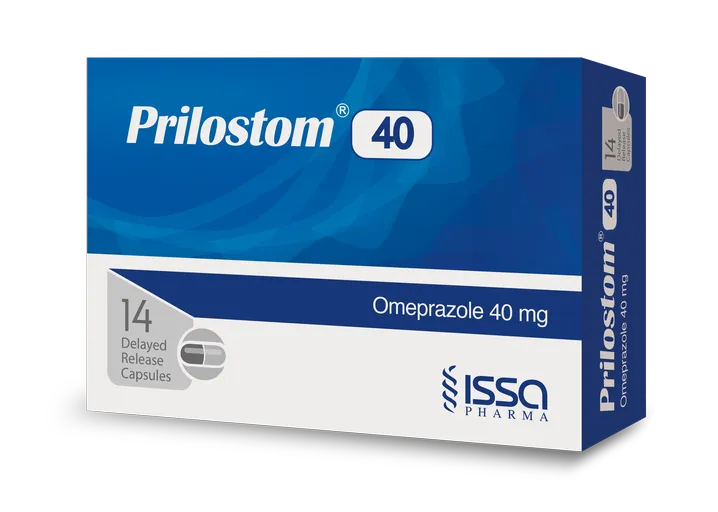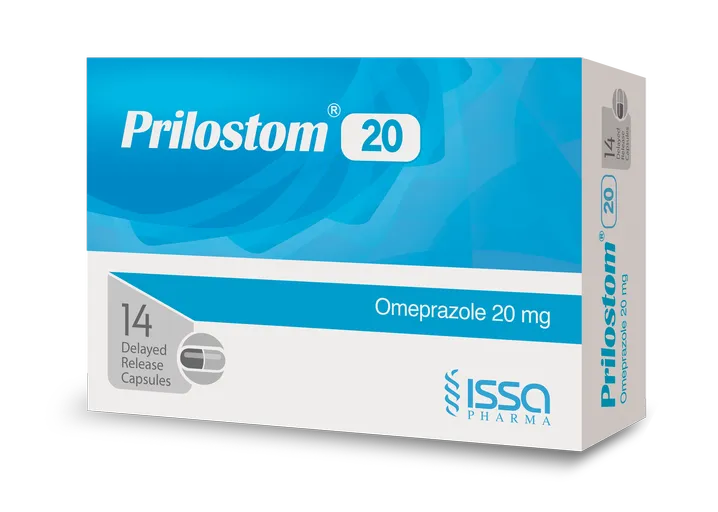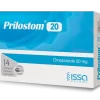COMPOSITION AND EXCIPIENTS
Each capsule of Prilostom 20 contains 20 mg Omeprazole (as D.R. Pellets).
Each capsule of Prilostom 40 contains 40 mg Omeprazole (as D.R. Pellets).
MECHANISM OF ACTION
Omeprazole belongs to a class of antisecretory compounds, that suppress gastric acid secretion by specific inhibition of the H+/K+ ATPase enzyme system at the secretory surface of the gastric parietal cell. Omeprazole has been characterized as a gastric acid-pump inhibitor, in that it blocks the final step of acid production. This effect is dose-related and leads to inhibition of both basal and stimulated acid secretion irrespective of the stimulus.
PHARMACOKINETICS
Absorption: Omeprazole delayed-release capsules contain an enteric-coated granule, so that absorption of Omeprazole begins only after the granules leave the stomach. Absorption is rapid, with peak plasma levels of Omeprazole occurring within 0.5 to 3.5 hours.
Distribution: Protein binding is approximately 95%.
Metabolism: Omeprazole is extensively metabolized by the cytochrome P450 (CYP) enzyme system.
Excretion: Following single dose, the majority of the dose (about 77%) was eliminated in urine as at least six metabolites.
INDICATIONS
Duodenal Ulcer:
- It is indicated for short-term treatment of active duodenal ulcer in adults. Most patients heal within four weeks. Some patients may require an additional four weeks of therapy.
- It is indicated in combination with clarithromycin and amoxicillin, for treatment of patients with H. pylori infection and duodenal ulcer disease (active or up to 1-year history) to eradicate H. pylori in adults.
- It is indicated in combination with clarithromycin are indicated for treatment of patients with H. pylori infection and duodenal ulcer disease to eradicate H. pylori in adults.
- Eradication of H. pylori has been shown to reduce the risk of duodenal ulcer recurrence.
- Patients who fail therapy Omeprazole D.R Capsules with clarithromycin are more likely to be associated with the development of clarithromycin resistance as compared with triple therapy. In patients who fail therapy, susceptibility testing should be done. If resistance to clarithromycin is demonstrated or susceptibility testing is not possible, alternative antimicrobial therapy should be instituted.
Gastric Ulcer:
it is indicated for short-term treatment (4 to 8 weeks) of active benign gastric ulcer in adults.
Treatment of Gastroesophageal Reflux Disease (GERD):
- Symptomatic GERD: it is indicated for the treatment of heartburn and other symptoms associated with GERD in pediatric patients and adults for up to 4 weeks.
- Erosive Esophagitis: it is indicated for the short-term treatment (4 to 8 weeks) of erosive esophagitis that has been diagnosed by endoscopy in pediatric patients and adults.
- The efficacy of it is used for longer than 8 weeks in these patients has not been established. If a patient does not respond to 8 weeks of treatment, an additional 4 weeks of treatment may be given. If there is recurrence of erosive esophagitis or GERD symptoms (e.g., heartburn), additional 4 to 8 week courses of Omeprazole may be considered.
Maintenance of Healing of Erosive Esophagitis: It is indicated to maintain healing of erosive esophagitis in pediatric patients and adults. Controlled studies do not extend beyond 12 months.
Pathological Hypersecretory Conditions: it is indicated for the long-term treatment of pathological hypersecretory conditions (e.g., Zollinger-Ellison syndrome, multiple endocrine adenomas and systemic mastocytosis) in adults.
CONTRAINDICATIONS
In patients with known hypersensitivity to substituted benzimidazoles or to any component of the formulation.
WARNINGS AND PRECAUTIONS
Concomitant Gastric Malignancy: Symptomatic response to therapy with Omeprazole does not preclude the presence of gastric malignancy.
Atrophic Gastritis: it has been noted occasionally in gastric corpus biopsies from patients treated long-term with Omeprazole.
Acute Interstitial Nephritis: Acute interstitial nephritis has been observed in patients taking PPIs including Omeprazole. It may occur at any point during PPI therapy and is generally attributed to an idiopathic hypersensitivity reaction. Discontinue Omeprazole if acute interstitial nephritis develops.
Cyanocobalamin (vitamin B-12) Deficiency: Daily treatment with any acid-suppressing medications over a long period of time (e.g., longer than 3 years) may lead to malabsorption of cyanocobalamin (vitamin B-12) caused by hypo- or achlorhydria. This diagnosis should be considered if clinical symptoms consistent with cyanocobalamin deficiency are observed.
Clostridium difficile Associated Diarrhea: Published observational studies suggest that PPI therapy like Omeprazole may be associated with an increased risk of Clostridium difficile associated diarrhea, especially in hospitalized patients. This diagnosis should be considered for diarrhea that does not improve.
Bone Fracture: Several published observational studies suggest that proton pump inhibitor (PPI) therapy may be associated with an increased risk for osteoporosis-related fractures of the hip, wrist, or spine. The risk of fracture was increased in patients who received high-dose, defined as multiple daily doses, and long-term PPI therapy (a year or longer). Patients should use the lowest dose and shortest duration of PPI therapy appropriate to the condition being treated.
Hypomagnesemia: Hypomagnesemia, symptomatic and asymptomatic, has been reported rarely in patients treated with PPIs for at least three months, in most cases after a year of therapy. In most patients, treatment of hypomagnesemia required magnesium replacement and discontinuation of the PPI. For patients expected to be on prolonged treatment or who take PPIs with medications such as digoxin or drugs that may cause hypomagnesemia (e.g., diuretics), monitoring magnesium levels prior to initiation of PPI treatment and periodically should be considered.
Interactions with Diagnostic Investigations for Neuroendocrine Tumors: Drug-induced decrease in gastric acidity results in enterochromaffin-like cell hyperplasia and increased Chromogranin A levels which may interfere with investigations for neuroendocrine tumors. Omeprazole should be stopped temporarily at least 14 days before assessing CgA levels and consider repeating the test if initial CgA levels are high.
Pregnancy: Teratogenic Effects, Category C
There are no adequate and well-controlled studies with Omeprazole in pregnant women. Omeprazole should be used during pregnancy only if the potential benefit justifies the potential risk to the fetus.
Nursing Mothers:
Omeprazole is present in human milk. Caution should be exercised when Omeprazole are administered to a nursing woman.
Pediatric Use:
Use of Omeprazole in pediatric and adolescent patients 2 to 16 years of age for the treatment of GERD and maintenance of healing of erosive esophagitis is supported by:
- Extrapolation of results from adequate and well-controlled studies that supported the approval of Omeprazole for adults, and
- Safety and pharmacokinetic studies performed in pediatric and adolescent patients.
The safety and effectiveness of Omeprazole for the treatment of GERD in patients <1 year of age have not been established.
The safety and effectiveness of Omeprazole for other pediatric uses have not been established.
Geriatric Use: no dosage adjustment is necessary in the elderly.
Hepatic Impairment: Consider dose reduction, particularly for maintenance of healing of erosive esophagitis.
Renal Impairment: No dosage reduction is necessary.
DRUG INTERACTIONS
Drugs for Which Gastric pH Can Affect Bioavailability: Due to its effects on gastric acid secretion, Omeprazole can reduce the absorption of drugs where gastric pH is an important determinant of their bioavailability. The absorption of drugs such as ketoconazole, atazanavir, iron salts, erlotinib, and mycophenolate mofetil (MMF) can decrease, while the absorption of drugs such as digoxin can increase during treatment with Omeprazole.
Digoxin: Co-administration with Omeprazole is expected to increase the systemic exposure of digoxin. Therefore, patients may need to be monitored when digoxin is taken concomitantly with Omeprazole.
mycophenolate mofetil: Co-administration of Omeprazole in transplant patients receiving MMF has been reported to reduce the exposure to the active metabolite. Use Omeprazole with caution in these patients.
Effects on Hepatic Metabolism/Cytochrome P-450 Pathways: Omeprazole can prolong the elimination of diazepam, warfarin and phenytoin, drugs that are metabolized by oxidation in the liver.
- Warfarin: There have been reports of increased INR and prothrombin time in patients receiving proton pump inhibitors, including Omeprazole and warfarin concomitantly. Therefor these Patients may need to be monitored for increases in INR and prothrombin time.
- Although in normal subjects no interaction with theophylline or propranolol was found, Patients should be monitored to determine if it is necessary to adjust the dosage of these drugs when taken concomitantly with Omeprazole.
- There have been clinical reports of interaction with drugs metabolized via the cytochrome P450 system (e.g., cyclosporine, disulfiram, and benzodiazepines). Patients should be monitored to determine if it is necessary to adjust the dosage of these drugs when taken concomitantly with Omeprazole.
- Concomitant administration of Omeprazole and voriconazole (a combined inhibitor of CYP2C19 and CYP3A4) resulted in more than doubling of the Omeprazole exposure. Dose adjustment of Omeprazole is not normally required. However, in patients with Zollinger-Ellison syndrome, who may require higher doses, dose adjustment may be considered.
- Co-administration of cilostazol with Omeprazole is expected to increase concentrations of cilostazol and its active metabolite. Therefore a dose reduction of cilostazol should be considered.
- Drugs which induce CYP2C19 or CYP3A4 (such as St. John’s Wort or rifampin) can substantially decrease Omeprazole concentrations. Concomitant use of Omeprazole with St. John’s Wort or rifampin should be avoided.
Interference with Antiretroviral Therapy: For some antiretroviral drugs, such as atazanavir and nelfinavir, decreased serum levels have been reported when given together with Omeprazole, Concomitant administration with Omeprazole and drugs such as atazanavir and nelfinavir is therefore not recommended. For other antiretroviral drugs, such as saquinavir, elevated serum levels have been reported. Therefore, clinical and laboratory monitoring for saquinavir toxicity is recommended during concurrent use with Omeprazole. Dose reduction of saquinavir should be considered.
Combination Therapy with Clarithromycin: Concomitant administration of clarithromycin with other drugs can lead to serious adverse reactions due to drug interactions, Because of these interactions; clarithromycin is contraindicated for co-administration with certain drugs.
Clopidogrel: concomitant use of Omeprazole with clopidogrel should be avoided. Clopidogrel is a prodrug. Inhibition of platelet aggregation by clopidogrel is entirely due to an active metabolite. The metabolism of clopidogrel to its active metabolite can be impaired by use with concomitant medications, such as Omeprazole, that inhibit CYP2C19 activity. When using Omeprazole, consider alternative anti-platelet therapy.
Tacrolimus: Concomitant administration of Omeprazole and tacrolimus may increase the serum levels of tacrolimus.
Methotrexate: concomitant administration of PPIs and methotrexate may elevate and prolong serum levels of methotrexate and/or its metabolite, possibly leading to methotrexate toxicities. In high-dose methotrexate administration a temporary withdrawal of the PPI may be considered in some patients.
ADVERSE REACTIONS
Clinical Trials with Omeprazole Monotherapy:
The most common adverse reactions reported for treatment of duodenal ulcer, resistant ulcer, and Zollinger-Ellison syndrome with an incidence rate ≥ 2% included: headache ,abdominal pain , nausea , diarrhea , vomiting , and flatulence.
Additional adverse reactions that were reported with an incidence rate ≥1% included acid regurgitation, upper respiratory infection, constipation, dizziness, rash, asthenia, back pain, and cough.
Children 2 to 16 years of age: adverse reactions of the respiratory system were most frequently reported, and accidental injuries were reported frequently.
Dual Therapy (Omeprazole/clarithromycin):
Adverse reactions that differed from those previously described for Omeprazole alone were: taste perversion, tongue discoloration, rhinitis, pharyngitis, and flu-syndrome. (For more information on clarithromycin, read the clarithromycin prescribing information, Adverse Reactions section)
Triple Therapy (Omeprazole/clarithromycin/amoxicillin):
The most frequent adverse reactions observed in clinical trials using combination therapy were: diarrhea, taste perversion, and headache. (For more information on clarithromycin or amoxicillin, read the respective prescribing information, Adverse Reactions sections.)
DOSAGE AND ADMINISTRATION
Omeprazole delayed-release capsules should be taken before eating. In the clinical trials, antacids were used concomitantly with Omeprazole.
Omeprazole delayed-release capsule should be swallowed whole. For patients unable to swallow an intact capsule, alternative administration options are available.
Alternative Administration Options:
For patients who have difficulty swallowing capsules, the contents of an Omeprazole delayed-release capsule can be added to applesauce.
One tablespoon of applesauce should be added to an empty bowl and the capsule should be opened. All of the pellets inside the capsule should be carefully emptied on the applesauce. The pellets should be mixed with the applesauce and then swallowed immediately with a glass of cool water to ensure complete swallowing of the pellets. The applesauce used should not be hot and should be soft enough to be swallowed without chewing. The pellets should not be chewed or crushed. The pellets/applesauce mixture should not be stored for later use.
For adults:
Indication | Recommended dose | ||
Short-Term Treatment of Active Duodenal Ulcer | 20 mg Once daily | Most patients heal within 4 weeks, Some patients may require an additional 4 weeks of therapy | |
H. pylori Eradication for the Reduction of the Risk of Duodenal Ulcer Recurrence | Triple Therapy (Prilostom / clarithromycin/ amoxicillin) | 20 mg Prilostom + clarithromycin 500 mg + amoxicillin 1000 mg twice daily for 10 days | In patients with an ulcer present at the time of initiation of therapy, an additional 18 days of Prilostom delayed-release capsules 20 mg once daily is recommended for ulcer healing and symptom relief. |
Dual Therapy (Prilostom / clarithromycin) | 40 mg Prilostom once daily , plus clarithromycin 500 mg three times daily for 14 days | In patients with an ulcer present at the time of initiation of therapy, an additional 14 days of Prilostom delayed-release capsules 20 mg once daily is recommended for ulcer healing and symptom relief | |
Gastric Ulcer | 40 mg Once daily for 4-8 weeks | ||
Gastroesophageal Reflux Disease (GERD) | Symptomatic GERD (with no esophageal erosions) | 20 mg Once daily for up to 4 weeks | |
Erosive Esophagitis and accompanying symptoms | 20 mg Once daily for 4-8 weeks | ||
Maintenance of Healing of Erosive Esophagitis | 20 mg Once daily | Controlled studies do not extend beyond 12 months | |
Pathological Hypersecretory Conditions | 60 mg once daily | – Doses should be adjusted to individual patient needs. – Doses up to 120 mg three times daily have been administered. Daily dosages of greater than 80 mg should be administered in divided doses. – Some patients with Zollinger-Ellison syndrome have been treated continuously with Omeprazole delayed-release capsules for more than 5 years. | |
Pediatric Patients:
For the treatment of GERD and maintenance of healing of erosive esophagitis, the recommended daily dose for pediatric patients 2 to 16 years of age is as follows:
Patient Weight | Daily Dose |
10 < 20 kg | 10 mg |
≥ 20 kg | 20 mg |
Alternative administrative options can be used for pediatric patients unable to swallow an intact capsule.
OVERDOSAGE
Symptoms were transient, and no serious clinical outcome has been reported when Omeprazole was taken alone. No specific antidote for Omeprazole overdosage is known. Omeprazole is extensively protein bound and is, therefore, not readily dialyzable. In the event of overdosage, treatment should be symptomatic and supportive.
STORAGE CONDITIONS
Store at temperature between 20° – 25 ̊ C, protected from light and moisture.
PACKAGING
Prilostom (20 – 40) mg is supplied as blister strips (Aluminum – Clear P.V.D.C), each strip contains 7 or 10 capsules and each box contains 2 strips (14 or 20 capsules per box).



